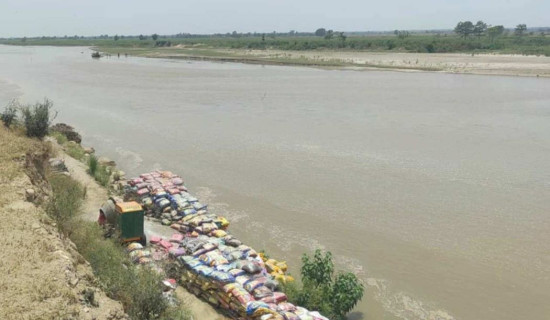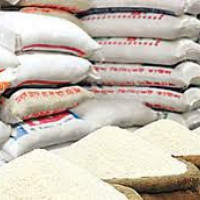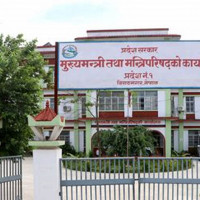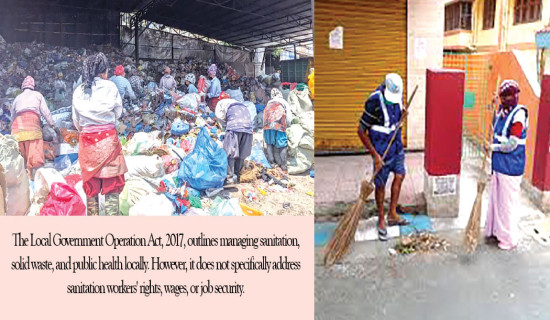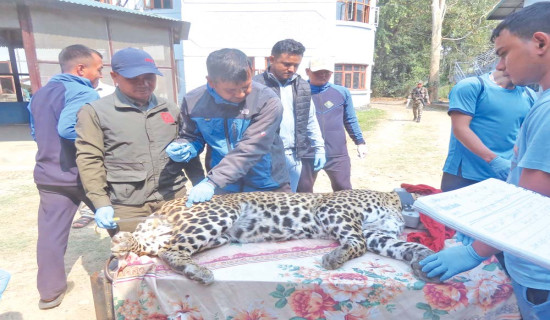- Wednesday, 8 October 2025
Mountain dwellers face grim prospect as springs dry up
Kathmandu, Mar. 12: Spring water plays a crucial role in sustaining life in the mountains. However, these essential water sources are drying up due to both natural and human-induced factors.
The root causes of this crisis are varied, including rapid infrastructure development, the aftermath of the 2015 earthquake, and the universal impacts of climate change, deforestation, floods, and landslides. Together, these factors contribute to the depletion of spring water sources or a reduction in their discharge capacity.
According to a research “Drying of Springs in the Himalayan Region of Nepal: Perspectives of Local Government Leaders on Causes, Consequences, and Conservation Efforts”, availability of water from natural springs is declining, posing a significant threat to millions of people's access to clean water and sanitation.
Dr. Ngamindra Dahal, a member of the research team and a climate change expert, stated that majority of people in the Himalayas depend on spring water, and they are facing challenges. He said, “We tried to identify local springs and assess how they are managed by local communities and authorities.”
The research team conducted phone interviews between July and August 2020, with leaders from 300 local government units across Nepal to identify the status of spring drying, the main causes, the consequences for local communities, measures adopted, conservation practices, and policies.
The research team discovered that springs had dried up in 74 per cent of local government units, with medium level to severe problems observed in 44 per cent of them. The scarcity of drinking water due to drying springs is the most severe issue, prompting outmigration in search of water, as reported by 7 per cent of the local governments, Dr. Dahal said.
According to the research, road and infrastructure construction without proper study is the main cause of spring drying up, followed by earthquakes and climate change. Problems of spring drying are more prevalent in the Chure region, followed by the mid-hills and mountains.
Local governments have used various strategies to mitigate the problem, such as rainwater harvesting, reforestation, lifting, and boring. Spring conservation work has been included in local governments’ annual plans, programmes, and budgets, but most of them focus on drinking water.
The local governments have adopted the slogan “one house, one tap” in their policies and are working towards providing one tap for each household. However, there is a lack of focus on spring management. “They have formulated policies without considering the condition of the springs. They only provide the tap, but without conserving the springs, how will they ensure a sustainable water supply?” Therefore, the problem must be addressed as quickly as possible with the participation of all stakeholders and following a bottom-up approach, he added.
According to ICIMOD, over the past 10 years, around 20 per cent of water springs have dried up across Nepal, and about 50 per cent have seen a reduction in their flow. This is a significant issue because roughly 10 million people in Nepal depend on spring water for drinking, household use, and some irrigation.
The drying of springs is causing serious problems, leading communities to consider moving to find water, however, there is a lack of detailed data. Dr. Dahal stressed the need for more research on the ground to better understand the issue.
At the heart of addressing this crisis lies the urgent need for a robust spring conservation policy. This policy should be underpinned by principles of decentralized governance, empowering local bodies and institutions to take charge of water management, particularly in rural areas where the impact of water scarcity is most acutely felt. However, despite the pressing nature of the issue, many local governments have yet to recognise it as a priority and implement effective policy instruments to tackle the root causes of spring drying, according to the research.
Dr. Dahal said that efforts to raise awareness among local communities about the importance of spring conservation are crucial for fostering a sense of ownership and stewardship over these vital water sources.
The severity of the problem varies across different provinces, with Bagmati Province experiencing the highest percentage of spring drying. Infrastructure development, including the construction of roads, emerges as a significant driver of spring depletion, alongside earthquakes and the broader impacts of climate change, according to the research.



